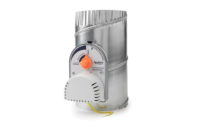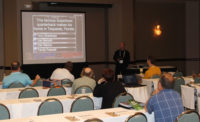CHICAGO — The concept of a “connected home” has been working its way into the public consciousness for decades. Even the idea of wirelessly controlling thermostats and other products has excited consumers around the world. The hype and buzz surrounding that premise is now starting to reach a fever pitch, as potential began giving way to reality at the 2015 AHR Expo in Chicago.
Connected Devices
Zoning manufacturers are creating equipment that grants consumers more options. Wi-Fi controls enable users access to controls and equipment tucked away in hard-to-reach or untouchable locations. Additionally, mobile applications provide users full control of their zoning system, anytime, anywhere.
Aprilaire, for example, is developing a mobile app for both Android and Apple devices that promotes connectivity between zones, allowing customers to change temperatures in different rooms of their homes. “We think the functionality and the ability to control multiple zones in one place is going to be really key moving forward,” said Mike Rimrodt marketing director, Aprilaire.
Communication amongst mechanical devices has really increased over the last 18 months, said Mike Reilly, EWC Controls Inc. “More and more equipment is being installed that will communicate with other devices, such as thermostats, zoning, water heaters, and more, via a four-wire connection. This helps reduce installation time for contractors due to a simple four-wire connection between devices.”
Tony Uttley, general manager, home comfort business, Honeywell Intl. Inc., said the Internet is driving the indoor environment.
“Internet connectivity is being utilized within the products to help people stay comfortable, understand the health of their systems, and save money,” said Uttley.
“From a contractor’s perspective, wireless controls help save time and money by eliminating the need to pull wire,” said Bryan Ware, portfolio manager, Trane, a brand of Ingersoll Rand. “In some cases, this eliminates the need to hire and manage a subcontractor to do the wiring, or, in some cases, reduces permit requirements. It’s all dependent on the job, type of building, and application, but it is an advantage for most contractors to apply wireless technology.”
Charlie Wilkinson, product manager of unitary systems, Trane, noted how Web-enabled controls give contractors the ability to remotely diagnose and troubleshoot a system rather than calling in a technician to diagnose and troubleshoot. This helps contractors be a half-step ahead in getting a troubled system back up and running.
Wireless technology is also a focus for Honeywell, as Uttley said the Lyric thermostat and app have been designed from the ground up to work as a part of an ever-expanding connected home platform so people who want to continue to buy and link together more Internet-connected products will be able to easily do so.
“Honeywell’s Lyric works seamlessly across the most common smartphone platforms to allow people to easily maintain their comfort and save money using our geofencing feature,” said Uttley. “Geofencing allows homeowners to set an invisible boundary around their homes. So, when the last person leaves, the system can be set back to save money, and when the first person arrives home, the system can return to the preferred comfort level. Geofencing takes the guesswork out of trying to set or learn a rigid schedule that many people just don’t have.”
However, mobile apps are just one aspect of zoning products thrusting the technology to the forefront of HVAC development. The products themselves are becoming smarter and more adaptable to the needs of consumers and contractors alike.
Alan Mfg. Inc.’s Wireless Zone Control Dampers feature a wireless power-open/power-close motor. Once the damper is installed into the duct work, all that needs to be done is to plug it in. The dampers feature an indicator light that glows green when the damper is open and red when the damper is closed. The damper is beneficial in open areas that have multiple diffusers and one thermostat. Instead of using a thermostat (or a dedicated app) to control the comfort level in each zone, the user can open or close specific dampers with a wireless remote control. The remote can control up to 32 different dampers and can be digitally set to control the actuator/damper from 0 percent (fully closed) to 100 percent (fully open).
The upcoming Haven home climate control system from Arzel Zoning Technology Inc. is pneumatically operated, wireless, and can operate up to 12 zones within a home. It can be battery-operated, but does not need to be, as it can run completely on the energy harvester within the system. The accompanying thermostat does not need to be wall-mounted and can be placed wherever a user chooses. The product also features separate apps for the contractor and the consumer.
Specified Controls Inc. offers the Pressure Independent Zone One, a round terminal air unit retrofit option for over-heating and over-cooling in specific areas or zones. The Pressure Independent Zone One is available in multiple sizes to handle 80 cfm to 4,200 cfm. The product is equipped with the SC-VAV controller and can also be integrated into any BACnet® control system. Accordingly, the BACnet-enabled zoning system from Specified Controls Inc. uses the ASHRAE standard BACnet protocol. It comes pre-configured with no programming or Tridium platform experience required for operation. The system can control up to 24 zones and control reheat in each zone.
Following the Regulations
While a major market driver, technological advancement is not the only factor in play in the evolution of zoning equipment.
Wilkinson noted that HVAC is a highly regulated industry. “Contractors are required to make sure HVAC systems, whether they are VAV [variable air volume], ductless, or light commercial packaged products, are in compliance with local and national codes, including Title 24 (a state regulation in California) and ASHRAE 90.1. Regulatory code compliance is going to be the biggest driver moving the industry forward. Title 24 requires VAV systems to be control-sequence compliant.”
According to Title 24, any newly constructed low-rise residential building including zonally controlled central forced-air cooling systems must be capable of simultaneously delivering, in every zonal control mode, airflow from the dwelling through the air-handler fan to the dwelling of greater than or equal to 350 cfm per ton of nominal cooling capacity.
The effects of Title 24 in California, and the chance it spreads throughout the country, will be important moving forward as it could have major implications throughout the zoning sector.
“Some early adopters of ASHRAE 90.1 consider Title 24 an opportunity for contractors to take the lessons learned through the regulatory process and implement them in other regions,” said Ware. “For example, California is always an early adopter. They’re applying things like low-leak economizers, fault diagnostics and detection, and other controls strategies to systems in general from an energy-efficiency perspective. If you’re a contractor with expertise in these areas, you may have the opportunity to be in front of customers more often as an expert, which might lead to more service or service contract opportunities.”
Dick Foster, president, ZoneFirst, assessed the overall state of zoning within the HVAC industry, stating: “Zoning is improving according to AHRI [Air-Conditioning, Heating, and Refrigeration Institute] numbers, but it’s still not as accepted as it should be,” he said. “The numbers are still below where they were six or seven years ago at this point. While the trend is improving, zoning is still a very small percentage of the overall market. For contractors, I find they would rather sell a mini split than get into the duct system.”
For now, the forefront of the zoning sector visibly lies within connecting devices and making the process of heating or cooling a home easier for both consumers and contractors.
Publication date: 2/23/2015
Want more HVAC industry news and information? Join The NEWS on Facebook, Twitter, and LinkedIn today!










